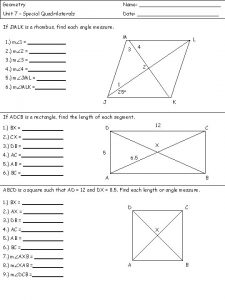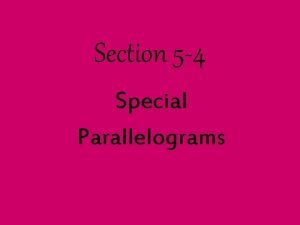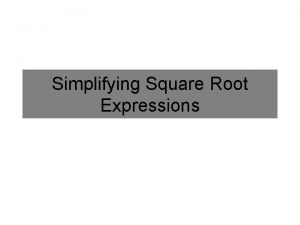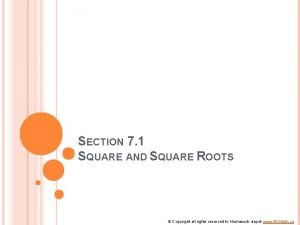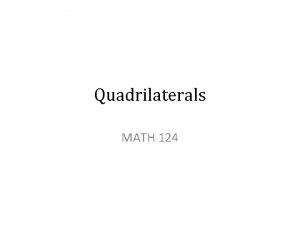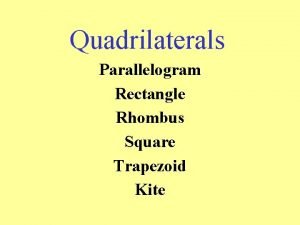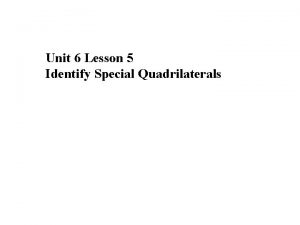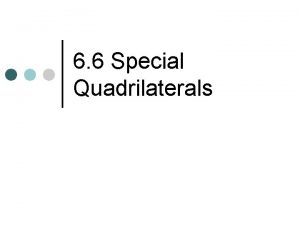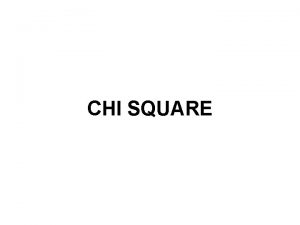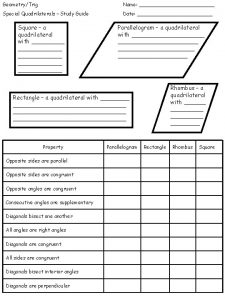CHAPTER 23 Quadrilaterals Special Quadrilaterals 1 Square a












- Slides: 12

CHAPTER 23 Quadrilaterals

Special Quadrilaterals 1. Square a) All sides are the same length b) All angles are the same size (90°) c) Its diagonals bisect each other at right angles d) Its diagonals are equal on length e) It has 2 pairs of parallel sides 2. Rectangle a) The opposite sides are equal in length b) All angles are the same size (90°) c) Its diagonals are equal in length d) It has 2 pairs of parallel sides e) Its diagonals bisect each other

Special Quadrilaterals 3. Rhombus a) All sides are the same length b) Opposite angles are equal c) Its diagonals bisect each other at right angles d) It has 2 pairs of parallel sides 4. Parallelogram a) The opposite sides are equal in length b) Opposite angles are equal c) It has 2 pairs of parallel sides d) It diagonals bisect each other

Special Quadrilaterals 5. Kite a) Its diagonals bisect each other at right angles b) Two pairs of adjacent sides equal c) One pair of opposite angles are equal 6. Trapezium a) One pair of parallel sides b) It has no axes of symmetry 7. Isosceles Trapezium a) One pair of parallel sides b) Non parallel sides equal c) Two pairs of equal angles d) Its diagonals are equal in length

Sum of the angles of a Quadrilateral The sum of the interior angles of any quadrilateral is 360°.

Symmetry of Special Quadrilaterals 1. Square a) It has 4 lines of symmetry b) order of rotational symmetry = 4 2. Rectangle a) It has 2 lines of symmetry b) order of rotational symmetry = 2

Symmetry of Special Quadrilaterals 3. Rhombus a) It has no axes of symmetry b) No rotational symmetry 4. Parallelogram a) It has no axes of symmetry b) No rotational symmetry 5. Kite a) It has one axis of symmetry b) No rotational symmetry

Symmetry of Special Quadrilaterals 6. Trapezium a) It has no axes of symmetry b) No rotational symmetry 7. Isosceles Trapezium a) One axis of symmetry b) No rotational symmetry Perimeter of Quadrilaterals The PERIMETER of a quadrilateral is the total length of its 4 sides.

Area of Special Quadrilaterals 1. Rectangle Area = Length x Breadth A = lb Breadth, b Length, l 2. Square Area = Length x Breadth In a square, Breadth = Length Area = Length x Length Area = Length 2 A = l 2 Length, l

Symmetry of Special Quadrilaterals 3. Rhombus Area = Base x Height A = bh Height, h Base, b 4. Parallelogram Area = Base x Height A = bh Height, h Base, b

Area of Special Quadrilaterals 5. Trapezium Area = ½ x sum of parallel sides x perpendicular height a Height, h b A = ½(a + b)h 6. Kite Area = sum of the areas of the 2 triangles

Area of a Triangle n The area of a TRIANGLE is calculated using the formula: Area = ½ x base x perpendicular height this is sometimes written as: Area = base x perpendicular height 2 A=½xbxh A=½x 8 x 6 A = ½ x 48 A = 24 cm 2 6 cm 8 cm
 Special quadrilaterals
Special quadrilaterals Classify polygons worksheet
Classify polygons worksheet Identify quadrilaterals
Identify quadrilaterals 5 properties of a rectangle
5 properties of a rectangle Venn diagram for quadrilaterals
Venn diagram for quadrilaterals Special types of parallelogram
Special types of parallelogram Irrational numbers
Irrational numbers How to foil in biology
How to foil in biology Square numbers up to 12
Square numbers up to 12 Square root of 225/16
Square root of 225/16 Square root
Square root The area of a square is 144144144 square centimeters.
The area of a square is 144144144 square centimeters. Is 72 a perfect square
Is 72 a perfect square
